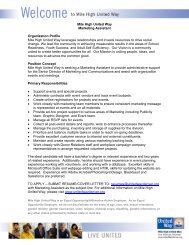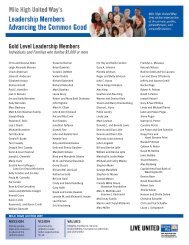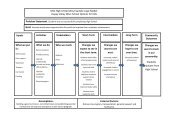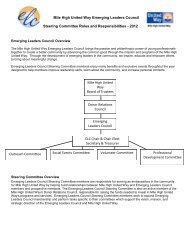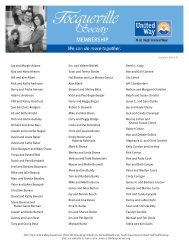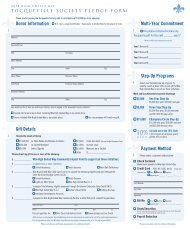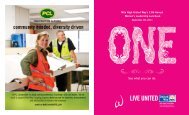SparkPoint Model - Mile High United Way
SparkPoint Model - Mile High United Way
SparkPoint Model - Mile High United Way
Create successful ePaper yourself
Turn your PDF publications into a flip-book with our unique Google optimized e-Paper software.
Why <strong>SparkPoint</strong>?<br />
<strong>United</strong> <strong>Way</strong> of the Bay Area is dedicated<br />
to creating pathways out of poverty.<br />
Our goal is to cut Bay Area poverty in<br />
half by 2020. Establishing <strong>SparkPoint</strong><br />
Centers throughout the region is essential<br />
to achieving this goal.<br />
More than 440,000 Bay Area households—nearly one in<br />
four—struggle to meet basic needs. Most (86%) have at<br />
least one worker, but still fall below the Self Sufficiency Standard<br />
– the income needed to pay for essentials such as food,<br />
shelter, health care and child care.<br />
People living in poverty face multiple, inter-related challenges.<br />
For example, someone who does not earn enough<br />
may need training to land a better job. He likely also needs<br />
help dealing with debt, managing credit, or developing a<br />
savings plan.<br />
Accessing help isn’t easy. Wading through confusing eligibility<br />
rules, scheduling multiple appointments, making trips to<br />
several offices, and filling out multiple forms all present major<br />
barriers to success. The result is people who are working hard<br />
to get out of poverty can’t get the help they need. <strong>SparkPoint</strong><br />
changes all that.<br />
<strong>SparkPoint</strong> Makes Accessing Help Easy<br />
integratED PERSOnal personalized<br />
servICES COACH PLAn<br />
Raising the Bar<br />
While the concept of a one-stop resource center is not new,<br />
<strong>United</strong> <strong>Way</strong>’s <strong>SparkPoint</strong> Centers elevate and improve on<br />
previous one-stop models.<br />
“Bundling” services<br />
»»<br />
Each Center brings together the region’s most effective<br />
programs to deliver integrated services as a single entity.<br />
All <strong>SparkPoint</strong> service providers use one system and set of<br />
metrics to track clients’ progress.<br />
»»<br />
<strong>SparkPoint</strong> urges clients to utilize two or more integrated<br />
services, which more effectively addresses the complex<br />
issues facing struggling households. We’re already seeing<br />
results: clients who used more than one service were three<br />
times more successful in achieving financial goals than<br />
clients who used only one.<br />
Client empowerment<br />
»»<br />
Every <strong>SparkPoint</strong> client is provided a coach, who helps<br />
create a step-by-step plan to achieve personal goals. The<br />
coaches serve as financial advisors, providing the guidance<br />
and support clients need to achieve long-term goals.<br />
»»<br />
Because financial success takes time, <strong>SparkPoint</strong> works<br />
with clients for as long as they need; for many, that is two<br />
or three years.<br />
»»<br />
Whereas traditional case managers act on a client’s behalf,<br />
making plans and enrolling clients in services, <strong>SparkPoint</strong><br />
coaches empower and encourage clients to act on their<br />
own behalf.<br />
»»<br />
<strong>SparkPoint</strong> builds on a nationally recognized, best-practice<br />
model—the Annie E. Casey Foundation’s Centers for<br />
Working Families—which has shown great promise for<br />
significant community impact. As such, <strong>SparkPoint</strong> Centers<br />
have the potential for high visibility, replication in other<br />
regions, and national impact.<br />
1 The Self-Sufficiency Standard, developed by Dr. Diana Pearce now at the Center for Women’s Welfare at the University of Washington, measures the actual cost<br />
of living for different household types in each county. Information about the Standard for California Counties is maintained by the Insight Center for Community<br />
Economic Development and can be found at www.insightcced.org. <strong>United</strong> <strong>Way</strong>’s “Struggling to Make Ends Meet” report details the Bay Area data related to<br />
the Standard and can be downloaded at www.liveunitedca.org.<br />
We are mightily impressed by the ambition of the <strong>SparkPoint</strong> Centers to tackle in a regional way the<br />
challenges facing low-income working families. They are an important partner in the Casey Foundation’s<br />
Center for Working Families national network, having adapted and continuously improving upon the model,<br />
furthering our knowledge in how to best deliver integrated economic services in low-income communities.<br />
Susan Gewirtz, Senior Associate, Center for Family Economic Success, The Annie E. Casey Foundation



